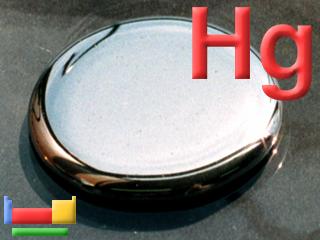
MERCURY

http://www.webelements.com/webelements/scholar/elements/mercury/key.html
Mercury is a metallic element situated in group twelve of the periodic table, in the third row of the transition series. Unusually mercury is the only metal to be liquid at room temperature and pressure. Its name is derived from the planet mercury, the closest planet to the sun in our solar system. Its chemical symbol is Hg derived from the Latin name for the element, hydragyrum, meaning liquid silver. Another name for mercury, used in old English is quicksilver coming from its appearance and liquid properties. Some other properties of mercury are shown in the table below:
| Melting Point | -38.87 °C |
| Boling Point | 356.58 °C |
| Atomic Radius | 1.76 Å |
| Atomic Volume | 14.82 cm³/mol |
| Density at 293K | 13.546 g/cm³ |
| Crystal Structure | Rhombohedral |
There are several isotopes of mercury but the most abundant are: mercury-202, 30% and mercury-200, 23%. No common isotopes of mercury are radioactive.
Mercury and its compounds has been known to many civilisations for millennia. The ancient civilisations of Egypt, China, Incas, India, Greek and Roman were all aware of metallic mercury and cinnabar, mercury sulphide was being used as far back as 30,000 years BC as a red pigment for paint.